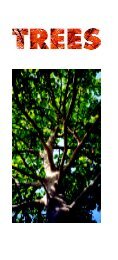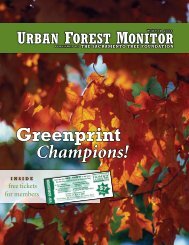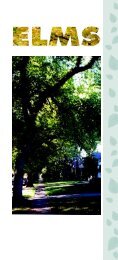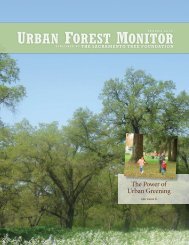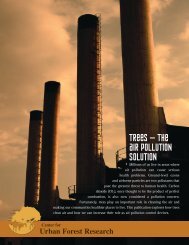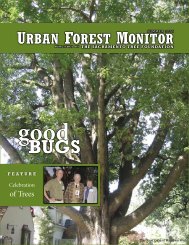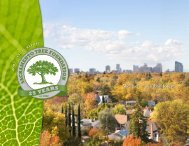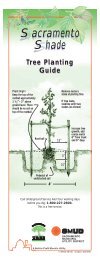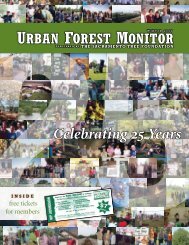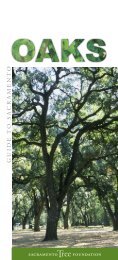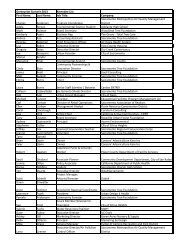Improving Fire Hazard Assessment at the Urban-Wildland Interface ...
Improving Fire Hazard Assessment at the Urban-Wildland Interface ...
Improving Fire Hazard Assessment at the Urban-Wildland Interface ...
Create successful ePaper yourself
Turn your PDF publications into a flip-book with our unique Google optimized e-Paper software.
Associ<strong>at</strong>ion (NFPA 299). In contrast towildland areas, this fuel m<strong>at</strong>rix requiresactive homeowner involvement in firehazard mitig<strong>at</strong>ion. This necessity hasresulted in regul<strong>at</strong>ions governing <strong>the</strong>landscaping practices by priv<strong>at</strong>e landownersin <strong>the</strong> high fire hazard areas of California(CA PRC 4291). Designed with <strong>the</strong>importance of fuels reduction and structuresurvivability in mind (Brown 1994, Cohen1995, Tran 1992, Foote 1991), PRC 4291requires defensible space for <strong>at</strong> least 10meters around <strong>the</strong> home. It limits ahomeowner’s choice of plant species,density, and placement and regul<strong>at</strong>esmaintenance practices such as pruningtrees and removing ladder fuels.Though compliance with PRC 4291 mayincrease fire safety, <strong>the</strong> law does notrecognize (1) <strong>the</strong> variability in <strong>the</strong> individuallandscaping preferences th<strong>at</strong> people have,or (2) <strong>the</strong> impact of neighboring parcels on ahomeowner’s fire hazard. Residents <strong>at</strong> <strong>the</strong>UWI have unique, individual sets of valuesand preferences th<strong>at</strong> are reflected in <strong>the</strong>landscapes <strong>the</strong>y cre<strong>at</strong>e and maintainaround <strong>the</strong>ir homes. These values oftenconflict with <strong>the</strong> principles of fire safety butproperty owners resist fire-safe regul<strong>at</strong>ionsif <strong>the</strong>y detract from wh<strong>at</strong> is valued in <strong>the</strong>landscape (Manfredo 1990, Abt 1991,Bailey 1991, Cortner 1991, Foote 1991,Smith 2001, Hodgson 1993, Winter 2000).In some communities, <strong>the</strong> combin<strong>at</strong>ion of<strong>the</strong>se two problems – small lot size andlandscape preferences – poses a significantbarrier to effective individual and communityfire hazard mitig<strong>at</strong>ion.This report describes a fire hazard analysisconducted on priv<strong>at</strong>e, developed lots inSouth Lake Tahoe, California. South LakeTahoe is a high fire hazard UWI communityin Nor<strong>the</strong>rn California where many of <strong>the</strong>developed lots are noncompliant with PRC4291 even though <strong>the</strong>re is active agencyoutreach and public support of fuelsreduction on undeveloped lots (Garrett,pers. comm., Harcourt, pers. comm.). <strong>Fire</strong>hazard was assessed according to <strong>the</strong>standards in NFPA 299, compliance withPRC 4291, construction m<strong>at</strong>erials of <strong>the</strong>home, irrig<strong>at</strong>ion practices, and <strong>the</strong> influenceon a parcel’s fire hazard by its immedi<strong>at</strong>eneighbors.Results indic<strong>at</strong>ed th<strong>at</strong> <strong>the</strong> overall fire hazardscore for <strong>the</strong> city was rel<strong>at</strong>ively low becauseof infrastructural components such as goodroads, w<strong>at</strong>er availability, signage, andfirefighting resources. Analysis of <strong>the</strong>components th<strong>at</strong> involve homeowner choiceonly (e.g. defensible space, maintenance,irrig<strong>at</strong>ion, and construction m<strong>at</strong>erials)indic<strong>at</strong>ed limited individual, parcel-scale firehazard mitig<strong>at</strong>ion efforts.Study siteSouth Lake Tahoe has approxim<strong>at</strong>ely24,000 inhabitants and is loc<strong>at</strong>ed on <strong>the</strong>south shore of Lake Tahoe, adjacent to <strong>the</strong>Nevada border. The gre<strong>at</strong>er Lake TahoeBasin extends across 88,000 hectares intwo st<strong>at</strong>es (California and Nevada) and fourcounties (El Dorado, Placer, Douglas andNevada). Its elev<strong>at</strong>ion ranges fromapproxim<strong>at</strong>ely 1900 m <strong>at</strong> <strong>the</strong> surface of <strong>the</strong>lake to about 3300 m <strong>at</strong> Freel Peak.Historically, fires in <strong>the</strong> Tahoe Basin wereprobably low and medium intensity surfacefires, occurring every 15 – 25 years andconsuming mostly light surface fuels, rarelybecoming stand-replacing events (Skinnerand Chang 1996). Eighty-five years of firesuppression in <strong>the</strong> basin (Murphy andKnopp 2001) combined with recent,prolonged drought conditions and extensivebug-kill have led to a build up of highlyflammable, hazardous fuel conditionsthroughout <strong>the</strong> area.The dominant conifer species in <strong>the</strong> lowermontane zone is ponderosa pine (Pinusponderosa), with some white fir (Abiesconcolor), incense cedar (Calocedrusdecurrens), and sugar pine (P. lambertiana).The upper montane zone (approx. 2000 –3000 m) is domin<strong>at</strong>ed by Jeffrey pine (P.jeffreyi) and also contains red fir (A.2




